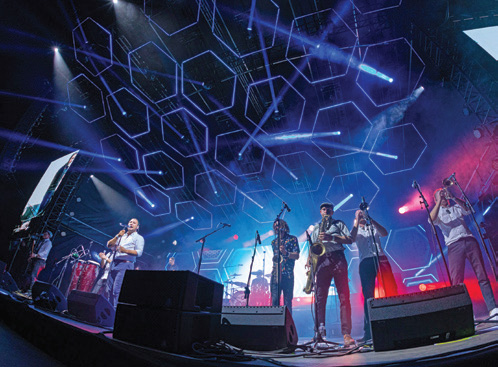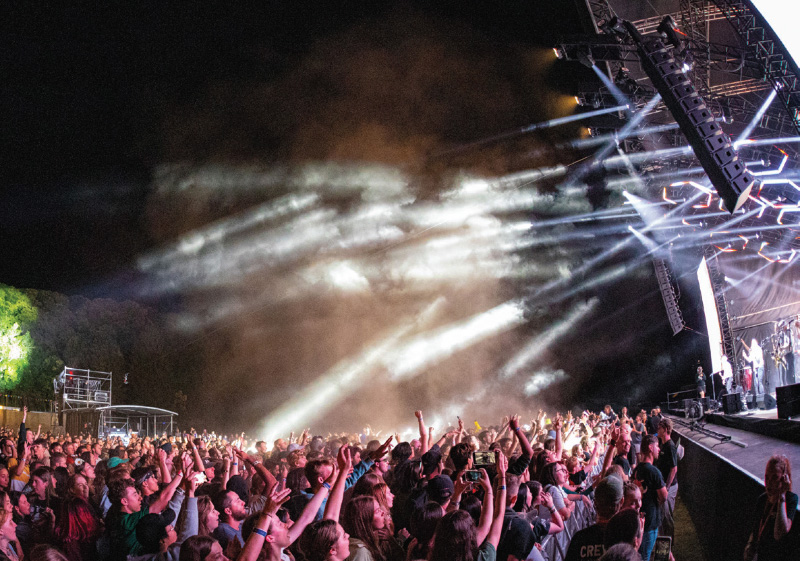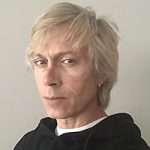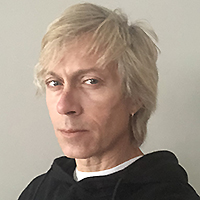For the 5,000-plus people attending the recent Festival One in Hamilton, New Zealand, the return of live music went from being a vague promise to a welcome reality – a chance to party like it was 2019 and take in a full-fledged live experience again.
Undoubtedly, the audiences and artists who performed over the three-day festival were thrilled to be there. But it’s a fair bet nobody was happier than audio engineer Benny Masterton, who designed the system and – as one of very few engineers in attendance – mixed many of the artist’s sets. “After almost 12 months of ‘retirement’ it was an absolute pleasure,” Masterton says. “I haven’t done this for so long, so I felt a bit rusty, but it was exciting to have that side of my brain working. And I was happy we had an Adamson system because I personally love their PAs, and knew I’d get exactly what I needed out of it.”
In addition to Masterton, who was acting as front of house system engineer and tech, also on-site were Festival One’s head of audio Peter Wood (who shared FOH duties and mixed the headliners each night) and Oliver (Olli) Barnett of Eleven Audio, who handled monitors for all but one band on the bill.

Masterton also mentions the patch team – Brendon Mchmahon and Theo Turner – crediting them with doing “a fantastic job wrangling the patch for such a variety of acts and performances,” adding that, overall, large-scale shows in the country are currently operating with far fewer crew members on site: “In New Zealand, it’s very rare that a show of any decent size and stature doesn’t include international artists and, of course, their touring crew and engineers.” On the one hand, it simplifies the shows to a certain extent, but it can also be challenging to recreate the production quality and “wow factor” people generally expect at shows that would normally feature a well-known, international headliner.
A Proper Gig
Originally from New Zealand, Masterton first began using Adamson rigs in North America as a system tech working with Eighth Day Sound, touring with various bands, and heading back and forth between North America, Europe, and home to avoid winter. “Which worked well,” he adds, “until last year.”
Like many people, Masterton found himself stranded well away from home when the pandemic hit. “I was on tour with Halsey. Manchester, on March 13th, was the last gig for us because of the lockdowns.” Rather than the three weeks he’d planned on spending in the UK, Masterton was there for nine months and only returned to New Zealand in early December 2020.

Given the success of New Zealand’s response to the pandemic, the nation has opened earlier than much of the world, but while Masterton has helped out on a few gigs since he got home: “They were nothing like this – this was a proper gig – a big festival, with a big stage and a big outdoor PA.”
Still, there were some pandemic-related precautions in place, he continues: “On entry, the festival staff prompted scanning in on the New Zealand Covid-19 tracker app and did normal H&S induction but there were no (physical distancing) restrictions in place. The festival went ahead in NZ alert level 1 – basically ‘life as normal’ but with masks mandatory on public transport and planes. And, of course, we wiped down microphones with antibacterial wipes between bands and had hand sanitizer at the ready. The only ‘PPE’ we had to wear were Hi-Viz vests, work boots, and SPF 50 sunblock because that week was an absolute scorcher.”
In all, the PA was comprised of a dozen Adamson S10 array modules per side and joined by 18 S119 subwoofers. “It was easily capable of doing a 5,000-person show with SPL to spare,” Masterton says, “and, as usual, I was blown away by the tone of the PA. Even over long distances, it keeps up with its bigger siblings like the E-Series.” Six 2-box stacks of dual Adamson Metrix cabinets were also deployed as front fill on the downstage edge of the stage in order to “fill in the intelligibility on the barrier,” he adds.

Additional system elements provided by Aukland’s Forge Production Services included a Soundcraft Vi3000 console and companion Vi stage box at front of house and a Lake LM 44 processor for the mains, along with a dozen Adamson M12 wedges on stage powered by Lab Gruppen PLM amplifiers and 12 stereo sets of Sennheiser G3 in-ear monitor systems.
“On the input side, monitors also had Olli’s own DiGiCo SD12 console working with a fully loaded SD-Rack with 56 channels of input cards,” adds Masterson. “For wireless mics, it was eight channels of workhorse Shure UR4D systems with UR2 transmitters and BETA 58A capsules. Beyond that, the rest of the kit was pretty standard, although Peter Wood, another member of the audio team, also brought in a Buzz Audio DBC-M compressor, a great little 1U New Zealand-made diode compressor.”
The Right Ratio
While Masterton has used many loudspeaker technologies over time, Adamson’s S-Series was the right fit for Festival One: “Mainly because of the S10’s even tone, I knew it was going to provide me with that as well as the proper SPL ratio for the area. And, like all Adamson products, the S10, when its loud, it keeps its tone. With some other boxes, the louder they get, the more the tone changes. What I love about this system is that it’s so directional.”

That was particularly important for Festival One, he adds, because of the width of the site. It’s basically a large square. The coverage area was mainly a flat field with a slight hill at the back, about 80 meters wide and 60 meters deep to the bottom of the hill. Further, the event’s Stage Set stage was of a smaller type, separating the main PA hangs by only 14 meters or so. In response, he utilized as much trim as possible, putting the top of the arrays at just above 8 meters. Again, the primary concern was ensuring the tone remained consistent as the SPL dropped off toward the rear of the coverage area.
“The people sitting right at the back, in camp chairs on the hill, obviously wanted to hear the music but they weren’t there to dance and party and the subs were great for that,” Masterson notes. “The S119s do transients so well and, with just one driver in there, there’s no internal cancellation from the box, so you can shape the sound according to the type of music you’re mixing, which was beneficial because we had hip-hop, country, pop – everything you could imagine.”

Particular focus went into the configuration and spacing of the subs as well. Nine stacks of two S119s were spaced across roughly 20 meters. “In my placement and time offset I’d targeted 74 Hz, which in my opinion is around where subs become directional and therefore steerable,” he explains. “More importantly, it’s where they start to interact with the main hangs. It’s also worth noting that 74 Hz is the note D2 – the second-lowest D on an 88-key piano and the frequency of the open D string on a standard bass guitar. So, this helps with keeping the subs and PA ‘musical.’ With a [larger] E-Series PA, I might have gone lower, but with the S10s I target a little higher.”
By deploying the subs this way, Masterton was working to ensure an even low end across the width of the site. “When the outer stacks are at their full positive extension, the inner stack is at its full negative. This helps spread the low end and effectively ‘pulls’ it around the sides in the far-field (in this case just behind FOH). You may wonder about a null at FOH but with the PA being so close together the LF summing in the middle is quite noticeable and this helped even everything out across the listening area.”
Back To The Future
For Masterton, being temporarily retired prompted him to take more time to tune the system than he usually would: “I was like, ‘If there’s going to be one gig that sounds perfect, it’s going to be this one.’ It was just a pleasure to be in front of a big system again, just listening to it and letting the sound attack my body. We took the time to dial it in and it sounded really good.”

While there’s still some way to go before concerts become a regular occurrence again, this showed that there is light at the end of the tunnel. “More gigs are coming up,” he says, “but this one will stick with me – the truck doors opening, wheeling the speakers on stage – what a feeling. I just felt so much gratitude for being able to do this and living like we were back in 2019. Everyone was just happy to be there. I know the musicians had a great time, and the fact that not a lot of sound comes off the back of the Adamson PA was a big hit for both the musicians and our monitor engineers.”
With full-on, large-scale shows still a rarity, the success of Festival One in early 2021 is not only a good news story, but a sign that the promise of live gigs actually starting to come back is becoming a reality. Granted, he adds, “We’re at the very bottom corner of the world, we’re lucky in that. But the main thing is that we don’t take it for granted because at any point it could be all off.
“Here in New Zealand, like everyone, we’ve had a change in the landscape of events. We’ve gone from the tiny shows that big artists begrudgingly play because it’s so expensive to get here to being in the spotlight with the world watching and being the envy of the global events industry. During Festival One, one of the bands actually said something along the lines of, ‘Let me hear you one time for the biggest show in the world right now’.”
It’s not something, he concludes, that’s been typical stage patter in New Zealand until the present.















